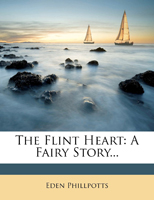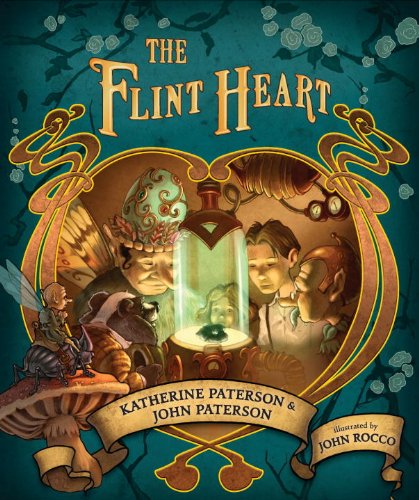The Flint Heart

The Flint Heart: A Fairy Story. Eden Phillpotts. E.P. Dutton & Co., 1910. Made available by Nabu Public Domain Reprints.

The Flint Heart. Katherine Paterson and John Paterson. Freely Abridged from Eden Phillpotts’ 1910 Fantasy. Illustrated by John Rocco. Candlewick, 2011.
Reviewed by Pauline J. Alama
[This review originally appeared in Mythprint 49:4-5 (#357-358) in April-May 2012.]
Eden Phillpotts’s 1910 fairy tale The Flint Heart takes as its starting point a fantasy of the Stone Age that holds almost eerie resonance with our own hyper-competitive age. Among the prehistoric tribes of Dartmoor in England, a warrior wanted power and position so badly that he paid a shaman to make him a charm to harden his heart. With the dubious blessing of the Thunder Spirit, the Flint Heart was created: a charm that made the bearer so ruthless that none could withstand him. After securing the warrior’s success and ruining his character, the charm was buried with its owner. For ages it did no harm, until a farmer unwittingly dug it up and fell under its spell.
The Flint Heart itself is a brilliant concept. Unfortunately, the story goes downhill from there, with one-dimensional, overly sweet child heroes and endless passages about cute little fairies dressed in flower petals—perhaps an example of what Tolkien, in his essay “On Fairy-stories,” called the “flower-fairies and fluttering sprites with antennae that I so disliked as a child, and which my children in their turn detested.” The plot of The Flint Heart is repetitious, and the solution to the problem could have been much more interesting if it forced the child protagonists to grapple with the problems of power and ambition that the talisman represents.
In their “freely abridged” version, Katherine and John Paterson perform the valuable service of both reviving a forgotten fable and clearing away some of the brush of bombastic verbiage, forgettable poetry, and overlong descriptions of fairyland delights that make the original version slow reading.
However, I regret their decision to trim away much of the sense of place from the original work. Phillpotts was evidently keenly interested in Dartmoor: its wildlife, its geography, its legends, and especially its prehistoric monuments, which I imagine may have provided the original spark for the story. In setting the stage for his story, Phillpotts described these monuments irreverently but in loving detail, giving credit to the purpose and workmanship of the stone age people:
They lived in the New Stone Age, and if you think that sounds dull, you never made a bigger mistake in your life. . . . (Phillpotts 11-12)
[W]hen you go to Dartmoor you will see what they left behind them in the shape of hundreds and hundreds of other stones. Some stand in circles, and some stand in rows, and some stand all alone; but you will mark in a moment, if your eyes are worth calling eyes, that these stones never happened by chance. They are very different from the tors and “clitters” and rock masses which are flung about all over Dartmoor. . . . (Phillpotts 12)
If you had seen the Moor when the New Stoners lived on it, you would have noticed strange little villages of very quaint-looking round huts, like giant beehives in clusters. And about them stood walls, and little folds for cattle, and circles of stones dotted in rings, where perhaps the Houses of Parliament met to fling more stones at each other. You will see also long rows of stones stretching far away to lonely spots on distant tors, where the great warriors and chiefs were buried. (Phillpotts 12-13)
The Patersons reduce Phillpotts’ description in a way that makes the story start more quickly, but loses the richness of the setting and conveys a dismissive attitude toward the Stone Age builders:
They raised the biggest stones in circles and lines and squares and all sorts of formations that nobody today quite understands the meaning of, and maybe they didn’t either. (Paterson 1-2)
But in many ways, the most remarkable thing about the Patersons’ “freely abridged” version is how little it employs the freedom to alter this public domain text. Other than modernizing a few expressions (by no means as many as they might have), the Patersons do not noticeably add anything to the story. It is puzzling that the publisher chose to name the Patersons, not Eden Phillpotts, as authors, and even the mini-biographies of the “Creators” at the end of the book profile the Patersons and the illustrator but not Phillpotts.
As long as contemporary writers set out to “freely” abridge an old story, I wish they’d been bolder. I would be interested in seeing The Flint Heart thoroughly made new for the twenty-first century: take the original stone age incident more or less unchanged, but have the Flint Heart rediscovered by a modern middle manager or small-town official and show how hard-heartedness and ruthless ambition play out in contemporary society. If the scenery of Dartmoor no longer inspires, then transplant the story to another location and use its geography and archaeology to root the story in a well-developed setting.
In his 1910 fairy story, Phillpotts sometimes seemed to play for laughs by juxtaposing exotic elements among the fairies or the Stone Age primitives with familiar, banal items from the everyday lives of his audience, like a discarded hot-water bottle made in Germany, or the subjects Edwardian children studied in school. There also seem to be references to contemporary events aimed over children’s heads at their parents, such as a villain’s campaign slogan, “Down With the Veto.”
Today, these once-familiar touches feel even more distant to a contemporary audience than fairyland or the Stone Age. In these passages, I wish that the Patersons’ version were either more scholarly or more of a wholesale retelling of the story.
A scholarly version would explain cultural references in footnotes: What politician was satirized when the Jacky Toad protests, “Down with the Veto!”? Why is it important to mention repeatedly that the hot-water bottle was made in Germany?
On the other hand, a thorough retelling of The Flint Heart could have replaced outdated modernisms with new ones, using what translators call “dynamic equivalence” — recreating the effect instead of the form. It would have been a much bigger project, of course, but such a creative reimagining of the Edwardian fairy tale might have made the old work speak to a new age.
The Flint Heart: A Fairy Story. Eden Phillpotts. E.P. Dutton & Co., 1910. Made available by Nabu Public Domain Reprints.

